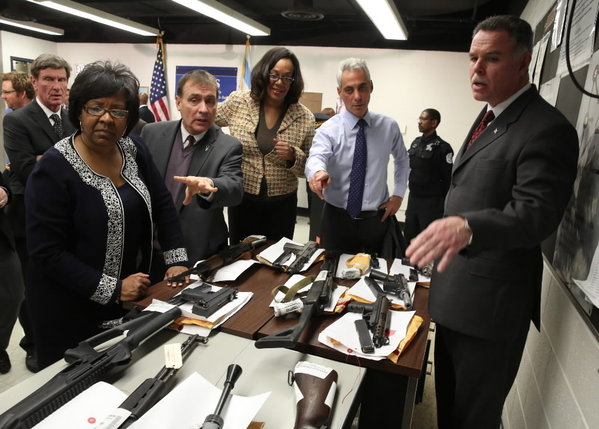
Rahm Emanuel is signaling that, despite the city and state's recent defeats—Chicago's gun ban, Illinois's concealed-carry ban—he's interested in tightening up the city's gun laws. Details are scarce, but you can see the direction he's going:
"Waiting is not a strong suit of mine," Emanuel said. "First of all, I believe there's, I know there's a majority in the state, an overwhelming majority in the city for a ban on assault weapons, clips, and comprehensive background checks on all sales, wherever they take place, wherever the location may be.
(The President made similar signals today in the final press conference of his first term.)
Could it help? It would be unlikely to do more than reduce gun violence at the margins; assault weapons and large magazines, while they're in the news for high-profile mass shootings, aren't really the problem in the vast majority of murders, which are generally committed with small-capacity handguns (PDF):
A study of shootings in Jersey City, NJ found that 10 or more rounds were fired in only 4.7 percent of the incidents. Koper indicated that the lack of statistically significant findings does not mean that the law did not prevent a small percentage of the over 10,000 firearm-involved homicides and nonfatal woundings of nearly 50,000 people annually. Even if the ban eventually prevented only 1 of every 5 of the five percent of incidents in which LCM are relevant, that would translate into about 100 fewer homicides and 500 fewer people wounded by gunshots per year. Such effects would not be definitively detectable with national data, but would be nonetheless meaningful, given the magnitude of the problem.
There's rough evidence that assault-weapons bans do reduce the number of assault weapons, but the percentage of guns used in crimes to the number of guns is already quite small. It doesn't take that many to commit crimes:
Criminologist Christopher Koper led a study to evaluate the federal assault weapon and LCM ban which revealed the limitation of the law’s impact. Just prior to the ban going into effect, production of assault rifles and assault pistols surged. Nevertheless, the percentage of crime guns recovered by police which were assault weapons dropped 70 percent between 1992-1993 (just prior to the ban) and 2001-2002. But assault weapons accounted for only 6 percent of all crime guns prior to the ban. For assaults with LCMs, which were used in 13 to 20 percent of gun crimes in selected cities, there was no detectable change in criminal use following the ban.
And the city is not in a gun-control vacuum. Before the ban was shot down, the majority of the city's guns originated elsewhere in the state, but they were obtainable from elsewhere, too—not just neighboring states, as you'd expect, but a high number came up from down south.
Related:http://www.dnainfo.com/chicago/2012-chicago-murders/explore-data DNAInfo has a good breakdown of the city's homicides in 2012. Of the 509, 440 were shootings.
Photograph: Chicago Tribune


